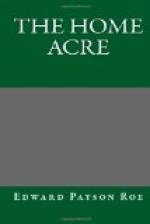Let us fix our attention on a single plant. It has a certain amount of root pasturage and space in which to grow. Since it is not permitted to produce an indefinite number of young plants, it begins to develop itself. The soil is rich, the roots are busy, and there must be an outlet. The original plant cannot form others, and therefore begins to produce fruit-crowns for the coming year. All the sap, all the increasing power of root and foliage, are directed to preparation for fruit. In brief, we have got the plant in traces; it is pulling in the direction we wish, it will eventually deliver a load of berries which would surprise those who trust simply to Nature unguided.
Some one may object that this is a troublesome and expensive way of growing strawberries. Do not the facts in the case prove the reverse? A plant restricted to a single root can be hoed and worked around like a hill of corn or a currant-bush. With comparatively little trouble the ground between the rows can be kept clean and mellow. Under the common system, which allows the runners to interlace and mat the ground, you soon have an almost endless amount of hand-weeding to do, and even this fails if white clover, sorrel, and certain grasses once get a start. The system I advocate forbids neglect; the runners must be clipped off as fast as they appear, and they continue to grow from June till frost; but the actual labor of the year is reduced to a minimum. A little boy or girl could keep a large bed clipped by the occasional use of a shears or knife before breakfast; and if the ground between the plants is free of runners, it can be hoed over in an hour. Considering, therefore, merely the trouble and expense, the single-plant system has the facts in its favor. But our object is not to grow strawberry plants with the least trouble, but to have strawberries of the largest and finest quality.
In addition to ease and thoroughness of cultivation, there are other important advantages. The single narrow row of plants is more easily protected against winter’s frosts. Light, strawy manure from the horse-stable serves well for this purpose; but it should be light and free from heat. I have seen beds destroyed by too heavy a covering of chunky, rank manure. It is not our purpose to keep the beds and plants from freezing, but from alternately freezing and thawing. If snow fell on the bed in December and lasted till April, no other protection would be needed. Nature in this latitude has no sympathy for the careless man. During the winter of 1885, in January, and again in February and March, the ground was bare, unprotected plants were badly frozen, and in many instances lifted partly out of the ground by midday thawing and night freezing. The only safe course is to cover the rows thoroughly, but not heavily, early in December. If then light stable-manure is not at hand, leaves, old bean-vines, or any dry refuse from the garden not containing injurious




